by Jodie T. Allen and Andrew Kohut
Why aren’t Americans happier about their economy? As Pew and other surveys continue to show, public sentiments about the economy remain far gloomier than at the start of the century, when seven-in-ten Americans (71%) told a January 2000 Gallup poll that they judged economic conditions in the country to be good or excellent. In contrast, at the start of 2006 just 34% of the public offered such a positive view of the national economy.
Analyses of Pew surveys have shown that, in contrast to the 1990’s, a huge partisan gap now divides Americans in their judgments of the national economy. Over the past five years, Republicans, Democrats and independents have looked at the same economic landscape, yet they come to different conclusions. Most Republicans see a rosy picture; Democrats and, increasingly independents, take a darker view of the economy generally, and, particularly, of the economy’s most salient signal – jobs.
One explanation for such an extraordinary disparity is that steadfast Republican support of President Bush and his policies carries over into judgments about the larger economy, while staunch and growing opposition to Bush among Democrats leads to a gloomy view of the economy. Still, it seems unlikely that partisanship would suddenly emerge as the single most important correlate of confidence in the nation’s economy. Other presidents, Clinton in particular, have also engendered strong partisan responses, but the evidence shows little hint of disparate partisan views of the economy as a consequence.
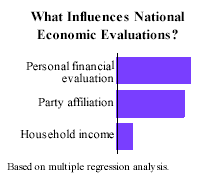
Why then are Democrats and Republicans now reacting so differently? The answer may well lie, at least in substantial part, in the growing gap between the personal financial and labor market experiences of average – and even somewhat above average – wage earners compared with those of people in the uppermost tiers of the job market. And personal experience matters. While regression analysis of survey data shows that partisanship is an important factor, self-perceived financial status remains at least as powerful a factor as determining how one views the national economy (more powerful if actual income is also taken into account).
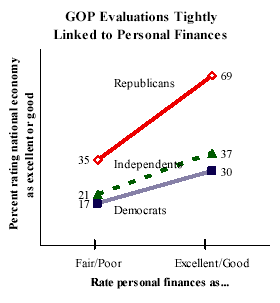
Moreover, the link between personal finances and national outlook turns out to be strongest among Republicans. Republicans who rate their personal financial situation favorably are overwhelming upbeat about the state of the economy. By and large, they feel well-off personally, and that good feeling carries over to their views of the larger world.
By contrast, Democrats and independents, even those who are doing well personally, remain doubtful. The differences in these readings of the economic scene may well be rooted in real world employment disparities. Economic studies show that in recent years only the most affluent workers have experienced real gains in wages. The top 10% of the wage scale have enjoyed most of the gains and they are heavily Republican.
In other words, even in today’s highly politicized climate, the causal link operates in both directions: political affiliation does, in substantial part, determine larger perceptions of the state of the economy. But average Americans also see the economy, and especially the job situation, through the prism of personal circumstance – and what they see may not be uniformly pleasing. And that perception, in turn, naturally affects their political choices.
Improving Indicators
No question, the macro-indicators are generally reassuring. Despite a gas price spike in the fall, inflation remains moderate by the standards of recent decades, as do interest rates. The unemployment rate, at 4.8% in February, is as low as it has been since mid-2001, while employers added 243,000 jobs to their payrolls and wages recorded a 3.5% increase over a year earlier. The economy grew at a respectable 3.5% inflation-adjusted rate last year, and most forecasters expect robust growth in the current quarter.
And in recent years productivity growth – the value of output per worker – has chugged along at a pace not sustained since the 1960s. That should be especially cheering news since productivity gains are traditionally viewed by economists as the primary engine of real growth in the incomes of average Americans. True, the latest data show U.S. worker productivity fell in the last quarter of 2005 for the first time in five years, but most economy watchers expect it to rebound in 2006, though perhaps not to prior growth levels.
Yet, despite the shallowness of the 2001 recession, only about a third of U.S. adults rated national economic conditions as good (30%) or excellent (4%) at the start of 2006. That’s an improvement over last October when gas prices were rising sharply and only 25% gave the economy a positive rating. Still, just 20% of the public now anticipates improving conditions over the coming year, roughly the same as the number (22%) who think conditions will worsen.
The Partisan Filter
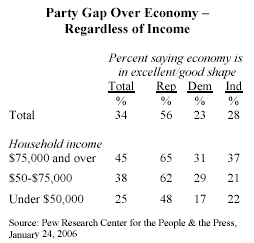
As noted, the most striking difference between today’s public opinion climate and that of earlier periods is the apparent importance of political party affiliation in determining peoples’ judgments about the strength of the national economy. Across all party lines, people focus on pretty much the same objective factors in making economic judgments, but, depending upon their partisan leanings, they take away different messages. In other words, partisanship is a potent processor of the lessons that the average person draws from the available facts.1
As described in a January 2006 Pew report,2 Republicans are far more likely than either Democrats or independents to see economic conditions as good or excellent; 56% of Republicans take that view compared with only 23% of Democrats and 28% of independents. These partisan differences in judgments about the economy are apparent across all income categories – and are not simply a matter of Republicans being wealthier on average than other citizens. But, again, party affiliation makes a bigger difference if you feel well-off: Republicans who rate their own personal financial situation as excellent or good are even more likely than Democrats and independents to give a similar rating to the national economy.

This strong party-line divide stands in stark contrast to the Clinton years during which optimism rose gradually at first among both Republicans and Democrats and then burgeoned toward the end of the decade, again across party lines. Still, it is noteworthy that in 1996, a year in which economic conditions closely paralleled current conditions, overall public judgments about the national economy were virtually identical to current views. That year, real GDP grew at a 3.7% rate, inflation ran at 3% and unemployment averaged 5.4% (falling to 4.7% by the close of the following year.) Yet in a March 1996 Gallup poll only 33% of the public deemed the national economy good or better.
But, as mentioned earlier, saying that Republicans feel better about the national economy and that Democrats feel worse does not, in itself, explain the direction of causality. Do GOPers, for example, see economic conditions as more favorable because they support the current administration, or are they administration supporters because they see economic conditions as working in their favor?
The data reveal that other factors – most notably views about the job market – are important drivers of both party affiliation and economic perceptions. Democrats and Republicans tend to focus on the same facts, but the conclusions they draw from them are strongly influenced by the state of their own personal finances.
The Importance of Jobs
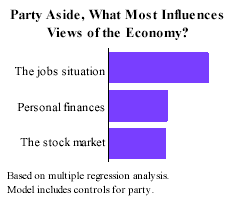
Regression analysis shows, as did similar analyses earlier in the year, that – partisan affiliations aside – judgments about the national job situation are most highly correlated with judgments about the overall economy. Close behind in independent importance are one’s own personal financial situation and views about the stock market.
While gas prices top the public’s stated list of economic concerns – in the January survey, fully 82% of Americans cite prices at the pump as either a very big (43%) or big (39%) concern – worry about energy prices is so ubiquitous that it does little to differentiate those with sanguine views of the larger economy from the pessimists.
But while people of all political persuasions focus on the job market in making judgments about the national economy, the lessons they draw from it differ sharply among partisan groups. Further analyses show that for Republicans, evaluations of the national economy are more strongly related to perceptions of the overall job market than is the case for either Democrats or independents.
And Republicans are upbeat about the job market. In Pew’s January survey, for example, only 38% of Republicans said that jobs were hard to find in their community. For the majority of Americans, however, the signals from the job market carry a far less cheerful message.
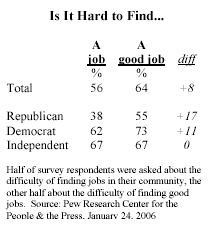
Overall, more than half (56%) of Americans said that jobs were hard to find in their communities – about the same proportion as a year earlier though fewer than in 2003, a recent low point. And fully 62% of Democrats and 67% of independents shared in that dismal view.
However, when asked whether a good job was hard to find, the proportion saying yes jumped significantly among both partisan groups, especially among Republicans – for whom, given their higher average incomes, good jobs may hold more personal significance than does the average job.
Similarly, a March 2006 Los Angeles Times/Bloomberg poll found that when respondents were asked what they considered the biggest economic problem facing the U.S., “jobs leaving the U.S.” essentially tied for first place with oil and energy prices and the Iraq war although Democrats (18%) and independents (17%) were more likely than Republicans (11%) to give jobs top billing.3
Still, with the national unemployment rate low, why are so many Americans down on the job market? In a recent study, “Where Did the Productivity Growth Go? Inflation Dynamics and the Distribution of Income,” economists Ian Dew-Becker and Robert J. Gordon of Northwestern University directly address the discontinuity between overall measures of economic performance and the experience of average Americans.4
Like other analysts,5 Dew-Becker and Gordon find increasing concentration of income at the high end of the distribution. But going beyond this to focus on the relationship between productivity growth and the wages and salaries received by workers, they reach a conclusion contrary to the normal expectation of economists: Over the last few decades – and increasingly in recent years – only those in the top 10% of the income pile have enjoyed an extra income kick from gains in hourly output.
And, as discussed earlier, analysis of survey data shows that while at every income level Republicans are more likely than Democrats or independents to rate general economic conditions as good or excellent, the gap is largest among those who rate their own personal financial situation as good or excellent.
[n]
Added workers have boosted household incomes – though at the expense of longer work hours, especially for lower-income worker. And cheap imports and easy credit – including substantial borrowing against the inflated value of homes – have bolstered buying power.7 But many homeowners have little cushion against falling home prices, higher interest rates or a general economic slump. A March L.A.Times/Bloomberg poll found that more than one-in-four with adjustable rate mortgages said they weren’t sure they could meet their monthly payments if interest rates rose. Also, of those who have refinanced their homes in the last two years or are considering doing so, only 4% had used or were considering using the cash for investments, and another 30% for paying off other debts. The remainder was allocated for spending of various kinds although a substantial part (40%) was earmarked home improvements or repairs which presumably add to the asset value of their homes.8
But, as polling data also show, soaring health care and college tuition costs press hard on middle-income budgets. Income mobility continues, though Dew-Becker and Gordon point to other studies showing that upward mobility in the United States is primarily a function of life cycle (the impoverished grad student goes to Wall Street) rather than wide-open opportunity.
Contrary to popular mythology, the economists also find that earnings gains have not flowed to “knowledge workers,” Instead the winners have been the CEOs and other “super-stars” of the latter-day U.S. economy. If “skill-based technical change” had been a major factor in the rise of income inequality, they argue, “then we should have observed an increase in the relative wages of those most directly skilled in the development and use of computers.”
Yet between 1989 and 1997, while the incomes of CEOs doubled or more, workers in jobs involving math or computers enjoyed only a 4.8% rise in real income while engineers took an average 1.4% pay cut.9 Some economists, such as former Federal Reserve Vice Chairman Alan Blinder, question whether even higher education still confers the competitive advantage to Americans that it once did. Writing in Foreign Affairs, Blinder observes that service workers – even high level ones such as doctors – are no longer immune to the pressures of globalization.10 Perhaps many Americans are unappreciative of today’s robust job scene because for most of them its benefits have yet to show up on their personal balance sheets.
Personal Finances as a Factor
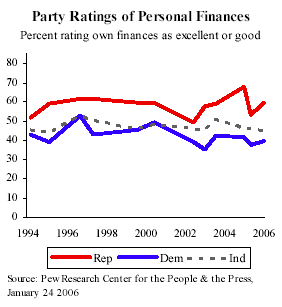
A closer look at those household books, reveals, not surprisingly, that ratings of one’s own current financial situation and expectations for the next year influence views about the health of the national economy. Currently, fewer than half (46%) of Americans rate their personal financial situation as good or excellent, about the same number as did so in May 2005.
Personal financial ratings continue to be more stable than judgments about the larger economy, perhaps reflecting less fluctuation in personal circumstances as well as greater knowledge of the facts close to home.
While the partisan gap in personal evaluations has not widened noticeably in recent years (after a brief enlargement in 2005), it remains significant. That is, again, unsurprising given that Republicans are, on average, significantly better off financially than either Democrats or independents. About one-in-three Republicans (32%) in recent Pew surveys has an annual income above $75,000, compared with 22% of Democrats and 25% of independents. By the same token 60% of Republicans rate their personal financial situation as good or excellent, compared with only 40% of Democrats and 45% of independents.
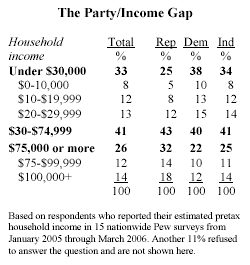
A recent Bloomberg/Los Angeles Times poll with a substantial oversample of high-earning individuals found that, as a group, those with incomes of more than $100,000 are most likely to say the economy is doing well: two-in-three make that assessment compared with fewer than half of those earning less than $50,000. As at other income levels, judgments of Bush’s economic stewardship among the most affluent split sharply along party lines with 77% of Republicans approving and 77% of Democrats disapproving. (Still, the poll found, a plurality of high-income Americans told pollsters that the economy is worse off because of President Bush’s policies while a majority said that former president Clinton did a better job in handling the economy.)11
As for future expectations, most Americans tend to be optimistic, at least at the personal level. Half (51%) think their financial situation will improve somewhat over the next year while an additional 10% expect it will improve a lot. Again, Republicans are the most sanguine, although partisan differences are much smaller than in evaluations of overall economic conditions. Among Republicans, 70% expect their personal finance to improve a lot or some over the next year, compared with 61% of independents and 59% of Democrats. These proportions have stayed relatively stable in recent years.
For Republicans as a group, regressions show that the most important external drivers of views about the national economy are jobs and, well behind, inflation. For Democrats, the rank order is inflation, jobs, home heating/energy costs and interest rates; for independents, jobs again lead the list followed by inflation, gasoline prices, home heating/energy costs, and interest rates.
Women tend to be more pessimistic about job conditions than men (30% rate the national job situation a very big problem, compared with 21% of men). But women tend to worry more generally than do men, with nearly half (49%) calling gas prices a very big problem compared with 38% of men, as well as the federal budget deficit (36% for women, 28% for men) and health care costs (48% to 32%).
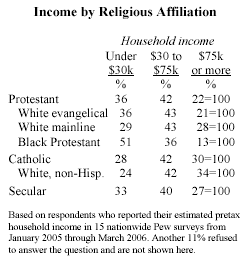
Among age groups, those in the middle ranges, ages 30-49 and 50-64, are significantly more likely to worry about the affordability of both health care and retirement than either younger or older age groups.
Nor are economics the primary driving factor behind partisan affiliation for all groups. For example, Evangelicals are among the strongest and most steadfast of the Bush administration’s political bases.12 And yet, their incomes are, on average, lower than those of non-evangelicals, with 36% earning under $30,000 annually, compared with 29% of white mainline Protestants.
Where the Trends Lead
As noted earlier, certain underlying trends in the national economy may help to explain why so many Americans do not share the generally optimistic view of many forecasters and macroeconomists. Among these, the modest growth in wages and the increasing concentration of income at the top have been the subject of growing attention among respected economists.
The most recent data from the Federal Reserve Board’s 2004 Survey of Consumer Finances suggest some diminution of this trend. The Board found that median before-tax family income rose only 1.6% (after adjusting for inflation) over the 2001-2004 period–far less than the “strong and broad gains” recorded between 1998 and 2001 and the “smaller but similarly broad gains between the 1995 and 1998 surveys.” However, also in contrast to those periods, mean (average) income fell by 2.3 %, a sign that income grew less rapidly at the high end of the distribution. This outcome, the Board noted, “appears to be a result of a decline since 2001 in investment income, which tends to be concentrated among high-income families.”13
But even as investment income sagged, far sharper was the decline in wage income. The overall median wage measured in the survey fell by 6.2% and, as the Board observes, “wages represent the largest share of family income.”
Notes
1Princeton professors Alan S. Blinder and Alan B. Krueger also conclude in a recent study, “What Does the Public Know About Economic Policy, and How Does It Know It?,” that on matters of economic policy, “ideology is the most important determinant of public opinion….” But they also find that “measures of self-interest are the least important. Knowledge about the economy ranks somewhere in between.” NBER Working Paper No. 10787, September 2004.
2Pew Research Center for the People & the Press, “Economy Now Seen Through Partisan Prism,” January 24, 2006.
3“Bush’s Popularity Slides Even Further,” Los Angeles Times/ Bloomberg, Study #525, March 2, 2006. Overall, while the poll finds a high level of discontent with President Bush’s handling of the economy (60% disapproval), it reports a lower level of discontent with economic conditions than do Pew surveys. In the LA Times/Bloomberg poll, respondents who say the economy is doing “fairly well” (49%) are added to the number saying it is doing “very well,” (7%) to produce a net positive rating. Like Pew surveys, the poll finds a sharp partisan divide with only 38% of Democrats saying the economy is doing even fairly well compared with 81% of Republicans.
4Ian Dew-Becker and Robert J. Gordon, “Where Did the Productivity Growth Go? Inflation Dynamics and the Distribution of Income, ” Brookings Papers on Economic Activity 2: 2005.
5For a variety of perspectives see, Thomas Piketty and Emanuel Saez, “Income Inequality in the United States, 1913-1998,” Quarterly Journal of Economics, Vol. CXVIII, February 2003; Isaac Shapiro, “What New CBO Data Indicate About Long–term Income Distribution Trends,” Center for Budget and Policy Priorities, March 2005; Martin Feldstein, “Income Inequality and Poverty,” NBER Working Paper No. 6770, October 1998; Jon E. Hilsenrath and Sholnn Freeman, “Affluent Advantage: So Far, Economic Recovery Tilts To Highest-Income Americans,” The Wall Street Journal, July 20, 2004; and “Moving Up: Challenges to the American Dream,” Four-Part Series in The Wall Street Journal, May-June 2005.
6Over the entire 1966- 2001 period, incomes in the 20-50 and 50-80 quantiles lost about one-fifth of their share of total wage and salary income, while the 95-99 and 99-99.9 quantiles increased their shares by 29% and 73% respectively. And the top one-tenth of one percent enjoyed a striking increase of 291%.
7Homeowners pulled a record $279 billion in cash out of their houses last year through refinancing and home-equity borrowing, according to recent Bloomberg report. See Mathew Benjamin, “Americans May Curb Spending, Credit Cards; Home Borrowing Ebbs” Bloomberg.com, March 13, 2006.
8Tom Petruno and Kathy M. Kristof, “Homeowners Expect Prices to Keep Rising,” Los Angeles Times, March 8, 2006.
9Dew-Becker and Gordon, op.cit.
10Alan S. Blinder, “Fear Of Offshoring,” Foreign Affairs, March/April 2006.
11Heidi Przbyla, “High U.S. Earners Criticize Bush Economic Policies,” Bloomberg.com, March 8, 2006.
12See Scott Keeter, “Evangelicals and Moral Values in the Election of 2004.” Paper presented at “A Matter of Faith? Religion and the 2004 Election.” Notre Dame University, December 2-3, 2005.
13“Recent Changes in U.S. Family Finances: Evidence from the 2001 and 2004 Survey of Consumer Finances,” Federal Reserve Bulletin 2006, p. A6




